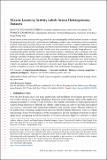Files in this item
XLearn : learning activity labels across heterogeneous datasets
Item metadata
| dc.contributor.author | Ye, Juan | |
| dc.contributor.author | Dobson, Simon Andrew | |
| dc.contributor.author | Zambonelli, Franco | |
| dc.date.accessioned | 2020-01-15T13:30:08Z | |
| dc.date.available | 2020-01-15T13:30:08Z | |
| dc.date.issued | 2020-01 | |
| dc.identifier | 264040093 | |
| dc.identifier | c926f1a5-9b77-4247-8855-9adc959dd227 | |
| dc.identifier | 85078822927 | |
| dc.identifier | 000567261000004 | |
| dc.identifier.citation | Ye , J , Dobson , S A & Zambonelli , F 2020 , ' XLearn : learning activity labels across heterogeneous datasets ' , ACM Transactions on Intelligent Systems and Technology , vol. 11 , no. 2 , 17 . https://doi.org/10.1145/3368272 | en |
| dc.identifier.issn | 2157-6904 | |
| dc.identifier.other | ORCID: /0000-0002-2838-6836/work/68280984 | |
| dc.identifier.other | ORCID: /0000-0001-9633-2103/work/70234210 | |
| dc.identifier.uri | https://hdl.handle.net/10023/19291 | |
| dc.description.abstract | Sensor-driven systems often need to map sensed data into meaningfully labelled activities to classify the phenomena being observed. A motivating and challenging example comes from human activity recognition in which smart home and other datasets are used to classify human activities to support applications such as ambient assisted living, health monitoring, and behavioural intervention. Building a robust and meaningful classifier needs annotated ground truth, labelled with what activities are actually being observed—and acquiring high-quality, detailed, continuous annotations remains a challenging, time-consuming, and error-prone task, despite considerable attention in the literature. In this article, we use knowledge-driven ensemble learning to develop a technique that can combine classifiers built from individually labelled datasets, even when the labels are sparse and heterogeneous. The technique both relieves individual users of the burden of annotation and allows activities to be learned individually and then transferred to a general classifier. We evaluate our approach using four third-party, real-world smart home datasets and show that it enhances activity recognition accuracies even when given only a very small amount of training data. | |
| dc.format.extent | 28 | |
| dc.format.extent | 5872738 | |
| dc.language.iso | eng | |
| dc.relation.ispartof | ACM Transactions on Intelligent Systems and Technology | en |
| dc.subject | Human activity recognition | en |
| dc.subject | Ensemble learning | en |
| dc.subject | Transfer learning | en |
| dc.subject | Clustering | en |
| dc.subject | Smart home | en |
| dc.subject | QA75 Electronic computers. Computer science | en |
| dc.subject | T Technology | en |
| dc.subject | 3rd-DAS | en |
| dc.subject | BDC | en |
| dc.subject | R2C | en |
| dc.subject | ~DC~ | en |
| dc.subject | SDG 3 - Good Health and Well-being | en |
| dc.subject.lcc | QA75 | en |
| dc.subject.lcc | T | en |
| dc.title | XLearn : learning activity labels across heterogeneous datasets | en |
| dc.type | Journal article | en |
| dc.contributor.institution | University of St Andrews. School of Computer Science | en |
| dc.contributor.institution | University of St Andrews. Sir James Mackenzie Institute for Early Diagnosis | en |
| dc.identifier.doi | https://doi.org/10.1145/3368272 | |
| dc.description.status | Peer reviewed | en |
| dc.date.embargoedUntil | 2020-01-10 |
This item appears in the following Collection(s)
Items in the St Andrews Research Repository are protected by copyright, with all rights reserved, unless otherwise indicated.

